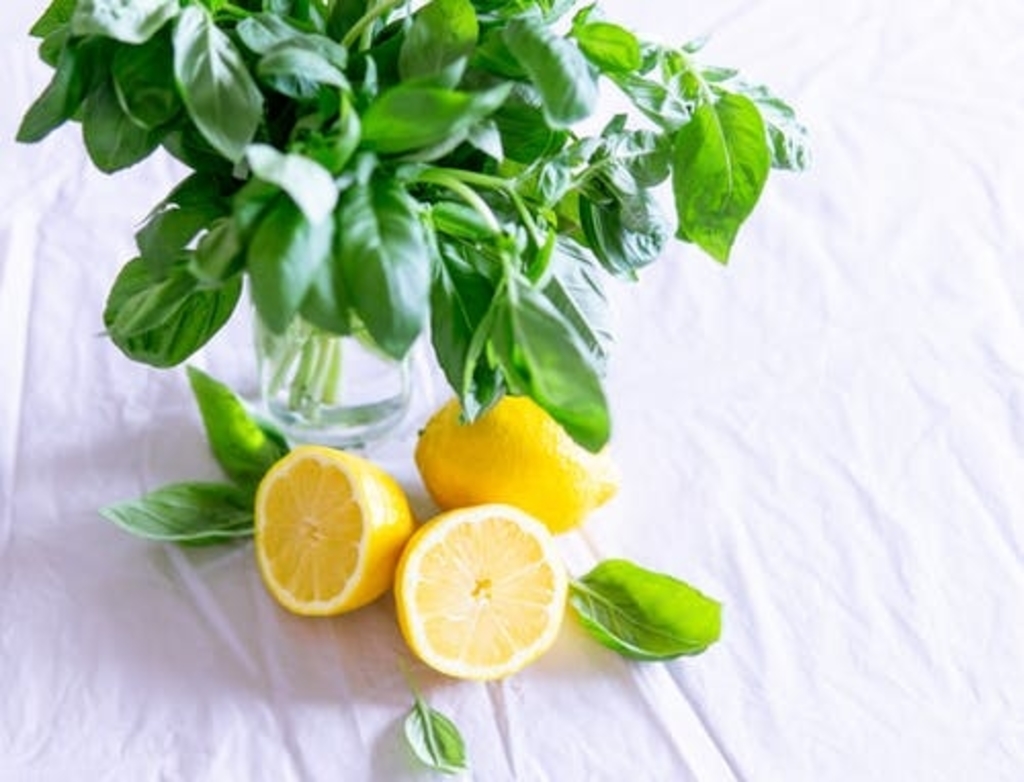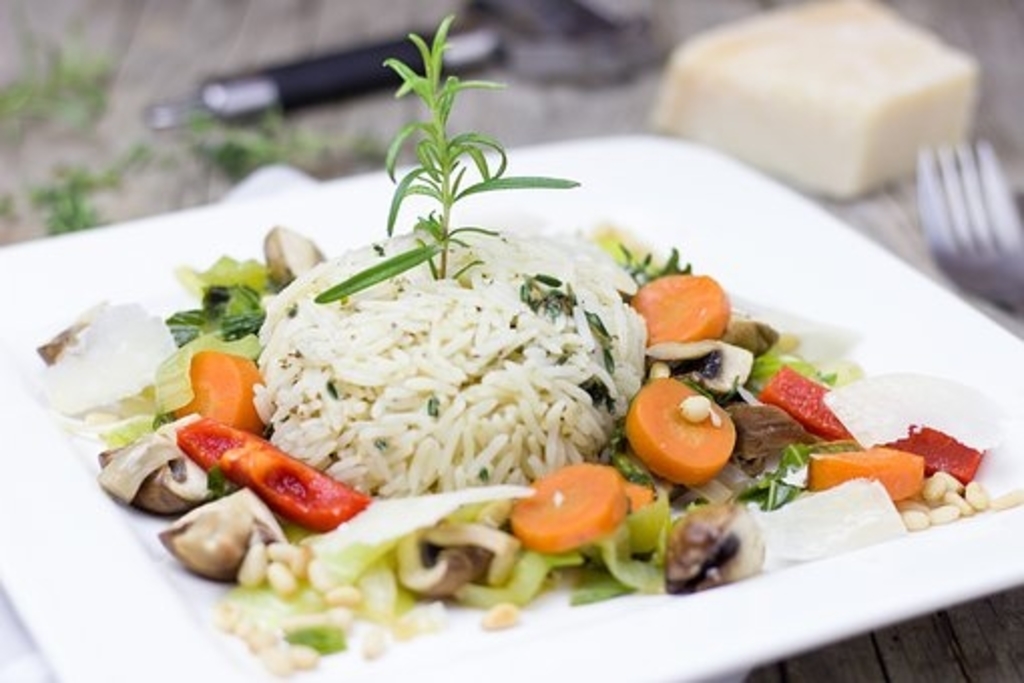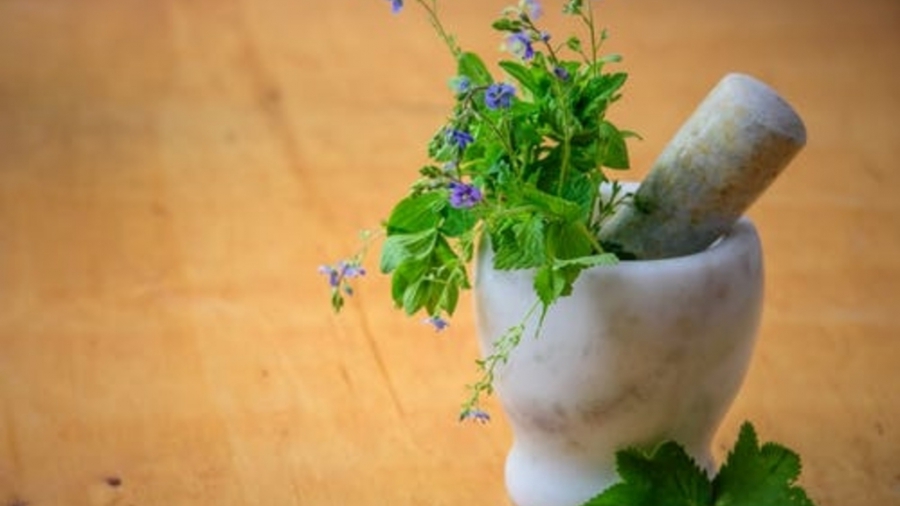By Chef Nancy Berkoff, RD, EdD, CCE
Cooking and eating for health have been around forever. In the bad old days, before there was a pharmacy down the street, someone in the community knew which plants or foods would possibly help to cure or prevent different diseases. Asian, Native American, and Indian medical systems have been in place for centuries and have employed herbs for health and to add wonderful taste to food!
Rosemary
Rosemary, that aromatic herb, is a natural antioxidant. It can have an antibacterial effect on food and an antioxidant effect on humans. What this means is that rosemary may actually reduce the bacterial levels in some foods, acting as a natural preservative. In humans, rosemary may help to reduce certain types of artery damage, thus helping to prevent some types of heart disease. And it tastes so good in soups and stews! Rosemary can grow into a full hedge, if given enough room. Perhaps you can include a pot of fresh rosemary in your kitchen on your windowsill or in your backyard. Fresh rosemary adds invigorating aroma to any area where it is placed as a bouquet. Rosemary wood (the branches remaining after the leaves are stripped) can be used as part of the wood placed in a fireplace or backyard grill.

Parsley and Basil
Fresh parsley and basil have concentrated levels of chlorophyll, the green pigment found in plants. Chlorophyll is thought to be a good ‘filter’; that is, it can help in maintaining the health of the stomach and small and large intestine. Eating chlorophyll-containing plants may help reduce the risk of some stomach and intestinal cancers. Chopped parsley and basil add wonderful texture, color and flavor to sauces, pasta, rice, and salads; throw some in and increase the health quotient of the dish.
Did you know that parsley is one of the most nutritious herbs around? All parsley varieties contain lots of vitamins A and C, some B vitamins and iron, potassium, magnesium, and calcium. Parsley is even beneficial for your plant friends. Many gardeners will tell you that parsley can improve the health of roses and tomatoes when planted in close proximity.
Parsley leaves come in two standard forms, curly leaf and flat leaf (also called Italian parsley or celery leafed). Within the two varieties there are many sub-varieties. Don’t confuse curly or flat leaf parsley with cilantro (also called Chinese or Spanish parsley or fresh coriander). Cilantro is distantly related to parsley, but has a very different taste. Think parsley for European, Mediterranean, Middle Eastern, Japanese, and North American dishes, and cilantro for Latin and South American, Thai, and Indian dishes.
Parsley is sometimes grown for its root, which resembles a bulbous horseradish but has a wonderful, mild flavor. Parsley root may be available in the springtime at local markets or farmers markets. Parsley root can be peeled and prepared just like potatoes. Mash parsley root along with potatoes, add diced parsley root to soups and stuffing, and even shave parsley root into salads. Freshly chopped parsley root spruces up tofu dishes, pasta, rice, savory entrées and vegetables, in addition to adding lots of nutrition without any sodium or fat. Also, if you have extra fresh parsley, wash and dry it, and freeze it to be used as you would dried parsley.
Mint
Mint belongs to a large family with over 30 species, the most common being peppermint and spearmint. Native to the Mediterranean and western Asia, mints interbreed so easily it is often hard for even the experts to distinguish and separate all the varieties. All mints have the volatile oil menthol, which gives mint that characteristic cooling, cleansing feeling. The leaves and flowers can be used in cold salads, hot beverages, and savory or sweet side dishes.
The Greeks believed mint could clear the throat and cure hiccups. Menthol, found in all varieties of mint except spearmint, has been used in headache and muscular pain cures. To make a soothing mint tea, steep about 1 teaspoon of dried mint leaves in 1 cup of boiling water. Prepare mint tea and allow it to cool in the refrigerator, for a refreshing beverage. You can use mint tea to steam or cook springtime veggies, such as fresh peas, snow peas, sugar snap peas (with edible peas and pod), carrots, and green beans.
Mint does well as a potted plant. This aromatic herb can help to keep ants and fleas at bay. In ancient and colonial times, mint leaves were kept near food, beds, and wardrobes as pest control.
There are many types of mint. Match the type you grow or purchase with the foods and beverages you like to prepare. Try chocolate mint for desserts, spearmint for drinks, peppermint for drinks and desserts, garden mint for general cooking, and pineapple mint for salads.
Here are just some of the many uses for fresh mint:
Teas: Fresh mint, spearmint, and peppermint sprigs are great to put in your teapot with your favorite tea. Pick the top of the mint plant off, wash it and add to your teapot. Steep for 2-3 minutes to the strength you prefer.
Tofu: Add chopped mint leaves to scrambled or baked tofu or to cold tofu salads. Add the mint at the end of cooking for a delicate flavor.
Salads: Fresh mint leaves are good with salads. Pineapple mint particularly is great in a mixed green salad. Mixed with cooked barley or bulgur, red onions, tomatoes, parsley, and lemony vinaigrette, it becomes similar to a tabbouleh, a refreshing Middle Eastern salad.
Steamed Vegetables: Mint is popularly used with peas. Carrots, potatoes, eggplant, white or black beans, and corn all perk up with the addition of freshly chopped spearmint. Add the herb at the end of the cooking process.
Lemongrass
Lemongrass acts like a magic wand, awarding everything it touches with a wizardly citrus aroma. Lemongrass is a native of India, Malaysia, and Sri Lanka. Many of us have been introduced to lemongrass in Thai and Vietnamese cuisine. Lemongrass has traveled throughout the world, adding its spell to soups, curries, sauces, rice, marinades, and teas. Fresh lemongrass looks like a stiff, solid, pale green onion and has a faint citrusy note. It pairs perfectly with fresh spring vegetables and with fresh green herbs, such as mint, parsley, basil, and sage.
In addition to enhancing foods, lemongrass extract and essential oils are important to the perfume and cosmetics industries. Lemongrass has long been used in traditional Indian medicine to fight fever and infection; you may have heard of its herbal name, fevergrass. Lemongrass was often used as part of a ‘cure’ for malaria. The actual lemongrass plant has roots so strong that it is planted in Southeast Asia to prevent soil erosion.
If you can’t find lemongrass at your local market, many Asian groceries carry it. Try to find spears with fresh, fat, light-green stalks. If the stalk has leaves, they should be green and tightly wrapped, not dried out or brown. Peel off the outer leaves and save them for flavoring broths, tofu dishes, rice, or pasta. Place the stalks upright in a bottle or jar of water in a sunny location. It may take a couple of weeks for them to root. Once they do, plant your lemongrass in a bright outdoor spot or pot them and let them grow indoors in a sunny window.
When purchasing lemongrass as a culinary ingredient, you can wrap extra stalks in brown paper or paper \towels; they can last 2 to 3 weeks in the refrigerator wrapped in this way. You can also freeze fresh lemongrass for several months. Remember to segregate lemongrass from any ingredients in the refrigerator you don’t want to end up tasting like lemon.
Lemongrass has a light, breezy, citrusy flavor. When you’re ready to cook with it, peel fresh lemongrass down to within about two inches of the small white bulb. The lower part of lemongrass stalks and the bulb are tender enough to eat.
The upper part of the stem is too tough to eat, but has a great flavor and aroma, so save it for cooking. Remember to remove tough pieces of lemongrass before serving.
Lemongrass can be combined with ginger, red or green chili, coconut meat, shallots, sweet bell peppers, or garlic as a flavoring blend. Simmer a piece of lemongrass in bean soups, vegetable or mushroom broths, fresh vegetable sauces, rice, or light creamy sauces. Add lemongrass to marinades for vegetables and to salad dressings or mashed avocado. If you are preparing a curry, add a small piece of lemongrass for a counterpoint flavor.
Lemongrass can be used as a ‘swizzle’ stick for hot herbal and black or green teas. Prepare a lemongrass tea with slices of fresh or dry ginger, add a piece of lemongrass and allow tea to steep. Serve this as a hot or chilled beverage or use as a broth for light, spring vegetables such as green peas, wax beans, pea vines or shoots, or baby carrots. It can also be used as a cooking liquid for white or jasmine rice, couscous, or Yukon Gold potatoes.
Garlic-Parsley Spread
(Makes 8-10 small portions)
Prepare this spread ahead of time and allow it to chill in the refrigerator. The flavors will ‘improve’ with time!
- 2 bunches curly leaf fresh parsley, chopped, stems included (about 1 cup)
- 2 cloves fresh garlic, minced
- ½ cup vegan mayonnaise, sour cream, or unflavored yogurt
- ½ teaspoon fresh lemon zest
- ½ teaspoon ground white pepper
Combine all ingredients in a medium bowl and mix well. Allow to chill for at least 1 hour before serving as a dip for freshly sliced vegetables or vegetable sticks, veggie or tortilla chips, breadsticks, or toasted pumpernickel or rye bread.
| Total calories per serving: 52 | Fat: 5 grams |
| Carbohydrates: 1 gram | Protein: 1 gram |
| Sodium: 120 milligrams | Fiber: <1 gram |
Lemongrass Rice
(Serves 4)
Fragrant and delicate, perfect to pair with light springtime vegetable dishes.
- Vegetable oil spray
- ¼ teaspoon ground turmeric
- 2/3 cup finely chopped onion
- ¾ cup water
- 2 stalks lemongrass, cut into 2-inch pieces
- 1 cup long grain white or brown rice
- 1 whole green onion, chopped (about 2 Tablespoons)
Spray a medium saucepan with oil and allow to heat. Add turmeric and chopped onion. Sauté until tender, about 3 minutes. Add water, lemongrass and rice and bring to simmer. Cover, reduce heat, and allow to cook until rice is tender and liquid is absorbed, approximately 15 minutes. Remove from heat and let stand for about 10 minutes. Remove and discard lemongrass.
Spray pan with vegetable oil; add green onion. Sauté quickly, about 1 minute, and stir into rice mixture. Serve hot.
| Total calories per serving: 181 | Fat: <1 gram |
| Carbohydrates: 40 grams | Protein: 4 grams |
| Sodium: 4 milligrams | Fiber: 1 gram |
Whipped Minted Yogurt
(Serves 8)
Serve this delightful topping with fresh fruit salad, over vegan sorbet or as a breakfast treat.
- ¼ cup sugar (vegan brand)
- ½ cup shredded fresh mint leaves
- ½ cup water
- 1 cup unflavored soy yogurt, well chilled
- 1 cup silken tofu, well chilled
Place the sugar, mint, and water in a saucepan over low heat and stir until the sugar has dissolved. Simmer for 4 minutes then let mixture stand for 5 minutes. Strain and cool.
Place the yogurt, tofu, and mint syrup in the bowl of an electric mixer and beat until light and creamy. Garnish with extra mint leaves when serving.
| Total calories per serving: 72 | Fat: 1 gram |
| Carbohydrates: 13 grams | Protein: 3 grams |
| Sodium: 13 milligrams | Fiber: <1 gram |

Parsley-Cheddar Rice (or for the children, Green Rice and Cheese)
(Serves 4 adults or 6 kids)
- Vegetable oil spray
- 3 cups hot cooked long grain rice (start with 1½ cups uncooked rice)
- 1½ cups shredded vegan cheddar cheese
- ¾ cup chopped fresh parsley
- ¼ cup minced green onion (white section only)
- 1 Tablespoon vegan margarine
- 1 teaspoon minced fresh garlic
- 1 cup soy or rice milk
Preheat oven to 375 degrees. Spray a medium casserole dish (about 1 quart size) with oil. Combine rice, 1 cup cheese, parsley, onion, margarine, garlic, and milk. Top with remaining ½ cup cheese. Bake uncovered for 20 minutes or until bubbly.
| Total calories per serving: 353 | Fat: 13 grams |
| Carbohydrates: 48 grams | Protein: 8 grams |
| Sodium: 447 milligrams | Fiber: 3 grams |

Vegetable Dumpling Soup
(Serves 6-8)
Enjoy this delicious soup!
Soup:
- 3 cups diced onions
- 2 cups peeled and diced parsley root
- 1 quart low sodium vegetable broth or water
- 6 carrots, peeled and diced
- 1 cup minced celery
- 2 bunches fresh parsley, minced, stems included, (about ¾ cup)
- 2 cups diced summer squash
- 1 Tablespoon fresh dill
- 2 teaspoons cracked black pepper
Place onions and parsley root in a large pot. Add broth or water. Bring to a fast boil. Lower heat, cover, and simmer for 45 minutes or until parsley root is tender. Add carrots, celery, parsley, summer squash, dill, and pepper. Cover and simmer for 1 hour or until all vegetables are tender and flavor is developed.
Dumplings:
- ½ cup water
- ½ cup soy or rice milk
- ¼ cup prepared egg substitute (see note) or silken tofu
- All-purpose flour (approximately 1½ – 2 cups)
Mix water and milk together in a medium bowl. Add egg substitute or silken tofu and mix. Add flour slowly, mixing, until mixture does not easily fall off your spoon. It will be a thick and gooey mixture (think of too-thick mashed potatoes).
Fill a 2-quart pot with 1 quart of water and bring to a boil. Drop dumplings by the tablespoonful into the water. Keep the water at a low boil and cook dumplings for approximately 45 minutes or until light and fluffy.
Remove dumplings from water and add to vegetable soup. Allow to cook for 5 minutes and serve hot.
Hint: Dumplings take up a lot of space when they are cooking, so do not fill your pot more than half full.
Note: Ener-G Egg Replacer can be used as an egg substitute. See ener-g.com.
| Total calories per serving: 246 | Fat: 1 gram |
| Carbohydrates: 52 grams | Protein: 7 grams |
| Sodium: 177 milligrams | Fiber: 7 grams |

Dill and Mustard Salad Dressing
(Makes about 1 cup)
Prepare this dressing and have it in the refrigerator to serve with green salads and fresh veggies right from the farmers market or the garden!
- 1 Tablespoon silken tofu
- 2 Tablespoons prepared mustard
- 2 teaspoons orange juice concentrate
- 2/3 cup sunflower or vegetable oil
- 2 Tablespoons white wine or champagne vinegar
- 3 Tablespoons chopped fresh dill
- 2 teaspoons white pepper
Place tofu, mustard, and orange juice in the canister of a blender. Process until just blended. With the blender running, drizzle in oil until the texture you would like is attained. Add wine or vinegar, dill, and pepper, then blend on high for 30 seconds. Refrigerate for at least 1 hour before serving.
| Total calories per 2 TB serving: 168 | Fat: 18 grams |
| Carbohydrates: 1 gram | Protein: <1 gram |
| Sodium: 44 milligrams | Fiber: <1 gram |
Nancy Berkoff is the VRG’s FoodService Advisor, as well as the author of Vegan in Volume and Vegans Know How to Party.By VRG website click here



Add a Comment